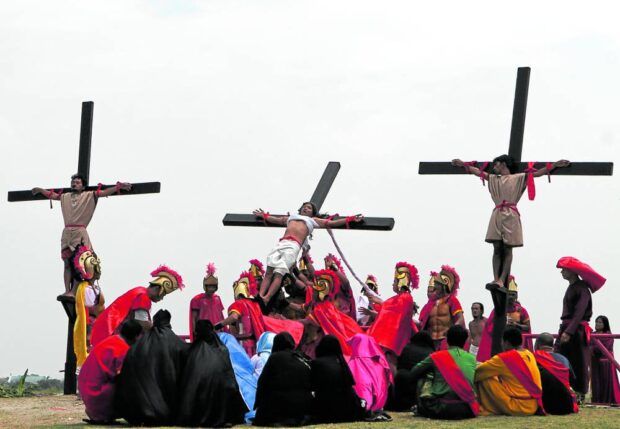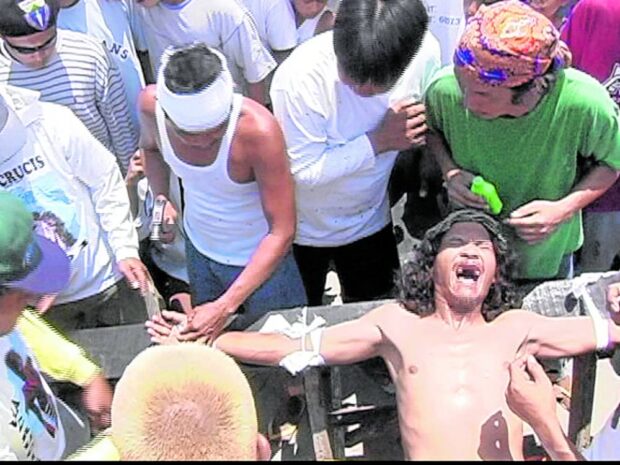Fewer crosses at Pampanga ‘Calvary’ as lead ‘Kristo’ nears retirement

SPIRIT IS WILLING, BUT. . . | Among those who have played Jesus Christ in the local “Golgotha” of Barangay San Pedro Cutud in the City of San Fernando, Pampanga province, Ruben Enaje has logged the most number of Good Fridays nailed to the cross. This photo was taken on April 6, 2004 (left). (INQUIRER FILE PHOTO)
CITY OF SAN FERNANDO, Pampanga, Philippines — The annual crucifixions in Pampanga province are drawing fewer and fewer participants each year.
The most prominent resident playing Jesus Christ is nearing “retirement’’ and local officials hope he will be succeeded by the most qualified new blood, so to speak.
Meanwhile, Archbishop Florentino Lavarias of the Archdiocese of San Fernando continues to discourage self-flagellation and calls on the flock to choose “other expressions of the faith rather than embrace pain.’’
The village of San Pedro Cutud in this city, where most of the crucifixions had been held, saw as many as 17 men taking part in the Good Friday tableau in 1986. That same year, Ruben Enaje began his “panata” (vow) and took the ritual to the next agonizing level by having two 4-inch nails driven through each palm, and a longer nail for the feet.
Tourist attraction
Enaje was not the first to be nailed to the cross in Cutud, where some of the penitents merely had their outstretched arms and propped-up legs bound to the wood by rope, but he holds the record for having consistently gone through the ordeal for more than three decades. In earlier interviews, he said it was his way of thanking God after he survived a fall from a three-story building that he was painting in 1985.In 2011, 24 men had themselves crucified in four villages in Pampanga and nearby Angeles City. In 2014, Cutud had only 12 ‘’Kristos,” but for the first time they included a foreigner, Danish filmmaker Lasse Spang Olsen.
Article continues after this advertisementThe lowest number of penitents was recorded in 2010, when only five men were raised on wooden crosses at the local version of Golgotha.
Article continues after this advertisementSo far, two women have taken up the challenge, which is called “papaku” in the local dialect. A former village chief, Zoilo Castro, identified one of them as Amparo Santos, a faith healer from Bulacan; the other was a nun from Belgium.
The Cutud crucifixions were started by a “traveling healer,” Artemio Anoza, in 1962 as a form of penance in San Fernando, the capital city of Pampanga. The Lenten folk tradition had since evolved, thanks largely to media coverage, into a local tourist attraction that evokes a mix of awe, pity and amusement.

SPIRIT IS WILLING, BUT. . .| Among those who have played Jesus Christ in the local “Golgotha” of San Pedro Cutud village in the City of San Fernando, Pampanga province, Ruben Enaje has logged the most number of Good Fridays nailed to the cross,. This photo was taken on April 6, 2004. (INQUIRER FILE PHOTO)
After pandemic pause
Since 2020, like most outdoor activities, the papaku has been suspended due to pandemic restrictions. As it resumes this Good Friday, Enaje, who became a senior citizen during the lull and now age 62, said it would likely be his last.
This year’s “Via Cruzis” (The Way of the Cross) may be his final act, and he will do it again out of a sense of Holy Week duty to his village where, since 1998, he has also led the “pabasa,” or chanting of verses recounting the passion and death of Christ.
“My palms and shoulders have been painful. I wish I am not going to be asked about the nails,” Enaje, feeling the weight of advancing age, said in an interview on March 12. “Last na sa ini, pero lawen ku (This is my last, I hope, but we’ll see).’’
Succession planning
As of Wednesday, the village council of Cutud has yet to find a suitable replacement for Enaje as the lead figure in the Via Cruzis and the pabasa, according to the barangay chair, Mat Ryan de la Cruz.
“We are looking for a man who has no bad record,” De la Cruz said. That man, he said, should have no criminal cases or a reputation for being a child abuser, wife beater or drug user. In short, “the Kristo must be a good man and acceptable to our people.”
De la Cruz said the council would meet soon about the candidates and that he may have to “scout” for Enaje’s successor among the other men who would be crucified with him tomorrow.
One thing is for sure: “The tradition we grew up with” is not ending just because Enaje is bowing out.
Longest-serving
Enaje would go down in local lore as the longest-serving Kristo: after his first nine years in the role, the billboard painter performed the next nine to seek graces for his daughter’s healing from asthma. The third set of nine years was for his wife’s good health.
During Via Cruzis, a street play dating back to 1955 depicting the 14 Stations of the Cross, Enaje carries a wooden cross weighing 37 kilos and measuring 15 feet in height for about 2 kilometers.
A procession of 5,000 or more barefoot “mandarame” (flagellants) follows in his wake, having first wounded their backs with glass shards or razor blades before whipping the flesh nonstop to crimson rawness.
The indigenous instrument of self-torture is called the “burilyo”—25 bamboo sticks tied together to form a scourge, designed to make a sound as they hit skin and muscle. The beatings tend to produce a rhythm, a crackling cadence of atonement, announcing the passing of the mandarame.
‘Blessings’
Spectators could only guess what goes on in the minds and utterings of the penitents, whose faces are concealed behind black veils called “kaparosa,” their heads crowned with guava leaves. Among the flagellants, some consider themselves more sinful than others: These “magsasalibatbat” show their heavier guilt by rolling on the hot pavement in front of churches or any rough, sandy patch along the way.
By noon the Via Cruzis should reach Calvary, a sun-parched clearing in Cutud’s Purok Cuatro that was made more hilly by lahar from the 1991 Mt. Pinatubo eruption.
Enaje could still recall one papaku where two women from Cutud approached to relieve him of his burden and took his cross, carrying it as they came to the last few meters before the crucifixion site. The women remained anonymous to him to this day since their faces were also covered.
“The blessings have been overflowing,’’ he said, when asked to look back and sum up his 33-year panata. “(My wife) Nita has been healthy and now sponsors the pabasa. I never had any difficulty finding a job, and my family has never gone hungry.’’